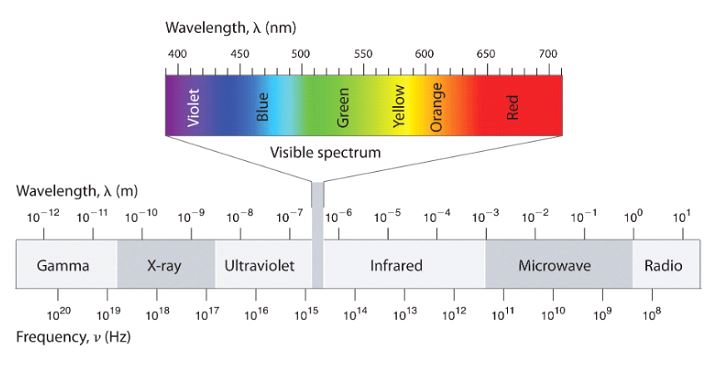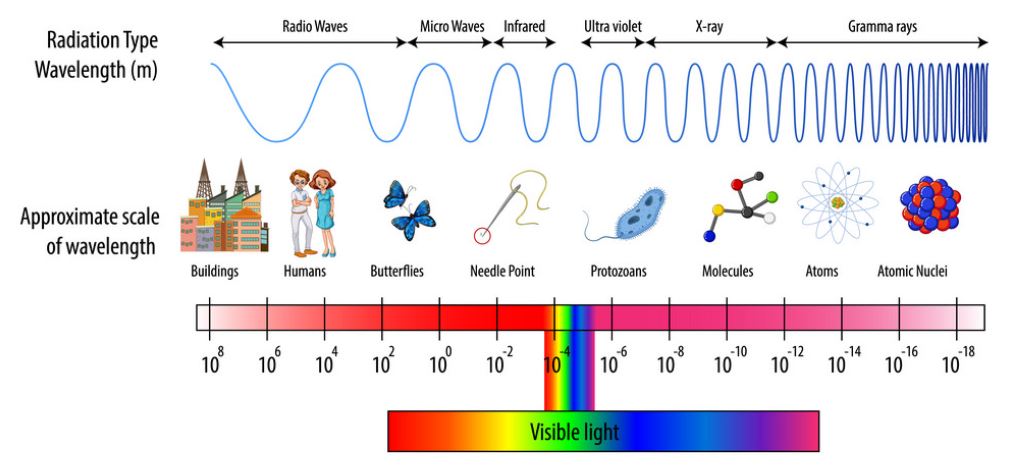You might be familiar with the term “wave” and associate it with the water waves in oceans and rivers, but the concept of the wave is much broader. Let’s learn about waves in general and electromagnetic radiations in specific!


What is a Wave?
The term wave can be defined as a disturbance that travels from one point to another in a medium or space and in the course of its travel, transfers energy but not mass. The oscillations produced are usually periodic and repetitive. The most common examples of waves are sound, light, and water waves. Wavelength is characterized by the symbol ‘λ’.
Types of Waves
Waves can be broadly classified into the following three types:
⦁ Mechanical waves: Require a material medium to propagate such as sound and water waves.
⦁ Electromagnetic waves: Not dependent on a medium for propagation and can travel even in a vacuum such as radio waves, visible light, etc.
⦁ Matter waves: A moving object having a linear momentum is considered a wave. It is the concept of quantum physics.
Electromagnetic Radiation
Electromagnetic radiation is the form of energy that is transmitted through an objective medium or space due to the periodic oscillation of electric and magnetic fields forming electromagnetic waves. The concept of electromagnetic radiation evolved after the development of electromagnetism theory by a Scottish physicist, Clerk Maxwell in 1873.
Examples: Electromagnetic radiations have surrounded us in various forms such as radio waves, X-rays, visible light, gamma rays, etc.
Properties of Electromagnetic Radiation
⦁ The electric and magnetic fields are at right angles to each other and the direction of the wave.
⦁ Do not depend on a material medium to travel.
⦁ In a vacuum, all the EM radiations travel with the speed of light, i.e. 3×108 m/s.
Electromagnetic Spectrum
All the electromagnetic radiation is arranged in a continuum based on their frequencies and wavelengths in an electromagnetic spectrum. The wavelength ranges from 101m (radio waves) to 10-12 (gamma rays). As the speed of EM radiations is constant, using their wavelength, one can obtain their frequencies by the following formula:
v = f λ


Types of Electromagnetic Radiation
⦁ Radio waves: Being the lowest in energy and longest (103m) in wavelength, radio waves are the building blocks of radio communications and are used in radio and television broadcasting, cell phones, and radars.
⦁ Microwaves (30cm to 1mm): They are used for communication like radio waves and are also used for remote sensing, radars, and heating purposes.
⦁ Infrared Rays (700nm to 1mm): Released in the form of heat, IR are also used in remote sensing.
⦁ Visible Light (380 to 700nm): Can be seen with the naked eye, emitted from sun.
⦁ Ultraviolet Radiation (100 to 400nm): They are non-ionizing radiations mainly emitted from the sun. They help in the production of vitamin D in the human body but are also harmful to the skin in excess.
⦁ X-rays (0.01 to 10nm): Mainly used in body imaging for diagnosis of various diseases.
⦁ Gamma Rays (<100 pm): Gamma rays have the shortest wavelength and the highest energy. They are used in radiotherapy, sterilization, and nuclear industry.
Check out other cool chemistry concepts with other chemistry kits below!

